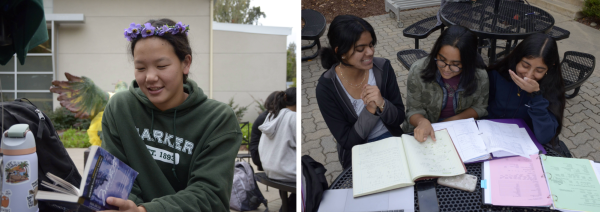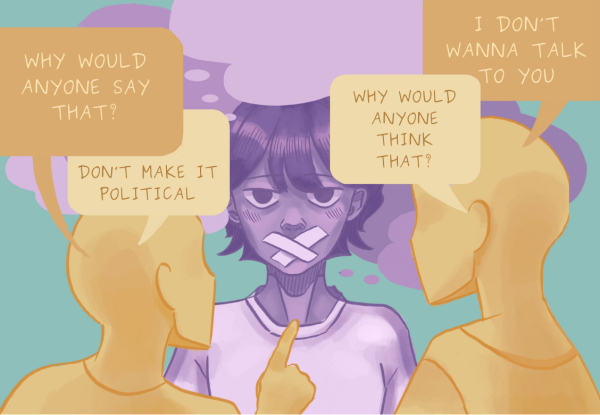Jetéing over gender stereotypes as a male ballet dancer
I was willing to try ballet as something I hadn’t done before, yet the “absurdity” of a male ballet dancer was also deeply ingrained in my mind. Once I discovered that ballet spoke to me in a different way than other genres, I decided to let my passion guide me.
A 10-year-old me walked into a ballet studio with my head down, trying to avoid the looks of other ballerinas. But I knew I was going to be noticed; as a boy, my short hair, white shirt and black tights starkly contrasted with the colorful leotards of other girls. From the moment I entered the classroom, joyful conversations were hushed into whispers, and I didn’t need to look up in order to feel the gazes boring into my head. Once I took my place at the barre, I finally looked up, and in the mirror saw myself, a thin, frail boy not knowing what to expect of the social norms in this ballet academy.
But, I thought to myself, maybe this would be a one-time experience; as I go to more classes throughout the year, perhaps I’ll get to know my peers better and form good relationships.
I misunderstood the rigidness of stereotypes in the ballet studio.
I would make mistakes in class. A lot of them. Compared to female dancers, I started my journey late; I began training when I was 9 years old, but girls usually begin during kindergarten or elementary school. So I was behind in terms of ballet technique, and I recognized that immediately.
What I also recognized was my classmates’ reactions to my failures, and how those reactions compared to the reactions to other dancers’ errors. Whenever I stumbled after a pirouette or fell to the floor from a jump, I would never receive the same encouraging words as when others make the same mistake. I became more afraid, more timid, more reluctant to seek help and improve.
For a long time, I would repeat the same pattern every class. Whenever I line up in the corner waiting for my turn to begin a ballet combination, I would feel the apprehension and the fear of messing up in the middle of the studio. The music would begin, I would make a grand entrance and flow with the music, moving with ease… until I step on the wrong foot. I would misapply my force, my movements would feel unnatural, and I would fall behind on the music. Everything escalates; I would feel the blood rising in my face until I finally regain control of myself. But instead of being able to find solace with other dancers, I would find myself trying to keep my embarrassment inside.
But even when I did make progress on a skill, I wouldn’t hear claps and cheers; I would just gain the privilege of not being whispered at. Why should it be harder for boys in particular to find a place in a ballet class; why should stereotypes of what boys are expected to do get in the way of their success in a ballet studio?
Stereotypes are the manifestation of our tendency to generalize the roles people play in society. We naturally build models of what is expected in the world, and it feels uncomfortable when this model is challenged by something unexpected.
We need to fight this instinct. Contrary to narrow-mindedness, open-mindedness is the foundation of “diversity” in not only ballet but also society in general. To foster a world where everyone feels welcomed no matter what they decide to pursue, we need to start by breaking our own stereotypes and be willing to challenge our own assumptions and traditional views of the world.
I struggled with this myself. I didn’t start off as a ballet dancer. I first found my passion for music in general when I watched and emulated Michael Jackson’s dances, and I thought hip hop would be my style. However, I was also willing to try ballet as something I hadn’t done before, yet the “absurdity” of a male ballet dancer was also deeply ingrained in my mind. Once I discovered that ballet spoke to me in a different way than other genres, I decided to let my passion guide me.
When I made this decision, I realized that the idea of a male ballet dancer is deemed more bizarre than it should be. I started to ask myself, “why is it ‘weird’ for me to be the only boy in class?” Because other ballerinas have rarely seen a male ballet dancer in a studio. “Is that really a justification for them to maintain the stereotype?”
Once I began to question myself on why it seems “weird” to be the only boy, I realized that perceptions of normal are very hard to rationalize. Nothing is intrinsically “weird.” “Abnormal” is a vague descriptor and does not have an indisputable definition like “blue” or “square”; rather, we define this concept. Although we may be uncomfortable changing our definition of normal, we may be more willing to challenge stereotypes once we realize that these perceptions are not actually the truth and are based on amorphous beliefs.
My story as a male ballet dancer is analogous to the norms in the rest of society. When people think about the most successful people on Earth, the first image that comes to mind is a prim, suave white man wearing a tuxedo, not an African American woman like Oprah Winfrey. Similarly, when people think about ballet dancers, people imagine a girl wearing a flower tutu daintily and gracefully stepping on stage, not a boy wearing tights and performing leaps.
Challenging stereotypes is uncomfortable, but once we recognize the importance of attempting this and can bring ourselves to do this, we take a large step towards a more inclusive world. This way, those defying social norms can look up from the moment they enter the room.

Anwen Hao (12) is a columnist for Harker Aquila and the Winged Post, and this is his fourth year on staff. This year, he looks forward to continuing to...

Angelina Hu (12) is the co-editor-in-chief of the TALON Yearbook, and this is her fourth year on staff. This year, Angelina wishes to meet all of her deadlines...


















![“[Building nerf blasters] became this outlet of creativity for me that hasn't been matched by anything else. The process [of] making a build complete to your desire is such a painstakingly difficult process, but I've had to learn from [the skills needed from] soldering to proper painting. There's so many different options for everything, if you think about it, it exists. The best part is [that] if it doesn't exist, you can build it yourself," Ishaan Parate said.](https://harkeraquila.com/wp-content/uploads/2022/08/DSC_8149-900x604.jpg)




![“When I came into high school, I was ready to be a follower. But DECA was a game changer for me. It helped me overcome my fear of public speaking, and it's played such a major role in who I've become today. To be able to successfully lead a chapter of 150 students, an officer team and be one of the upperclassmen I once really admired is something I'm [really] proud of,” Anvitha Tummala ('21) said.](https://harkeraquila.com/wp-content/uploads/2021/07/Screen-Shot-2021-07-25-at-9.50.05-AM-900x594.png)







![“I think getting up in the morning and having a sense of purpose [is exciting]. I think without a certain amount of drive, life is kind of obsolete and mundane, and I think having that every single day is what makes each day unique and kind of makes life exciting,” Neymika Jain (12) said.](https://harkeraquila.com/wp-content/uploads/2017/06/Screen-Shot-2017-06-03-at-4.54.16-PM.png)








![“My slogan is ‘slow feet, don’t eat, and I’m hungry.’ You need to run fast to get where you are–you aren't going to get those championships if you aren't fast,” Angel Cervantes (12) said. “I want to do well in school on my tests and in track and win championships for my team. I live by that, [and] I can do that anywhere: in the classroom or on the field.”](https://harkeraquila.com/wp-content/uploads/2018/06/DSC5146-900x601.jpg)
![“[Volleyball has] taught me how to fall correctly, and another thing it taught is that you don’t have to be the best at something to be good at it. If you just hit the ball in a smart way, then it still scores points and you’re good at it. You could be a background player and still make a much bigger impact on the team than you would think,” Anya Gert (’20) said.](https://harkeraquila.com/wp-content/uploads/2020/06/AnnaGert_JinTuan_HoHPhotoEdited-600x900.jpeg)

![“I'm not nearly there yet, but [my confidence has] definitely been getting better since I was pretty shy and timid coming into Harker my freshman year. I know that there's a lot of people that are really confident in what they do, and I really admire them. Everyone's so driven and that has really pushed me to kind of try to find my own place in high school and be more confident,” Alyssa Huang (’20) said.](https://harkeraquila.com/wp-content/uploads/2020/06/AlyssaHuang_EmilyChen_HoHPhoto-900x749.jpeg)







